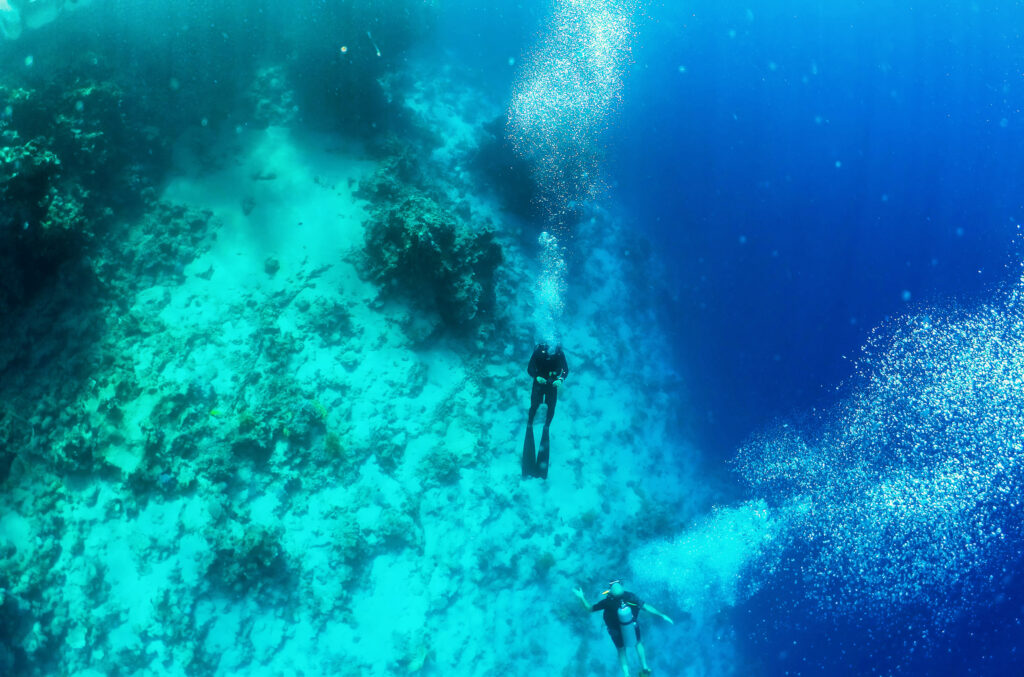What is Rapture of the Deep?

Rapture of the Deep, commonly known as nitrogen narcosis, is a condition experienced by scuba divers at significant depths. This phenomenon, resulting from the increased partial pressure of nitrogen when diving, can lead to a range of symptoms that affect cognitive and motor functions. Understanding Rapture of the Deep is crucial for divers to ensure safe practices and avoid potentially hazardous situations underwater.
What is a Manifold?

A manifold in scuba diving is an essential component that plays a crucial role in connecting multiple tanks to provide divers with a continuous and reliable air supply. This device allows for the seamless integration of two or more tanks, ensuring that divers can manage their air reserves efficiently and safely. Manifolds are particularly important in technical and deep diving, where extended bottom times and redundancy in air supply are critical. By linking tanks together, a manifold provides divers with the flexibility to access a larger volume of air, enhancing their underwater experience and safety.
What is Partial Pressure?

Partial pressure is a fundamental concept in physics and chemistry, particularly significant in the context of scuba diving. It refers to the pressure exerted by a single type of gas in a mixture of gases. Understanding partial pressure is crucial for divers as it influences how gases are absorbed, transported, and expelled in the human body under varying underwater conditions. This concept helps in comprehending how different gases behave under increased pressures encountered at depth and is essential for ensuring safety and preventing diving-related illnesses.
What is a Diver Propulsion Vehicle?

A Diver Propulsion Vehicle (DPV), also known as an underwater scooter, is a motorized device used by scuba divers to increase their range underwater with minimal physical exertion. By holding onto the DPV, divers can be pulled through the water at various speeds, allowing them to cover greater distances and access dive sites that would otherwise be challenging to reach. DPVs are used in various types of diving, from recreational to technical and even military applications, providing significant benefits in terms of efficiency and safety.
What is Closed Circuit Scuba?

Closed circuit scuba, commonly referred to as rebreather technology, represents a significant advancement in underwater breathing apparatuses. Unlike traditional open circuit scuba systems, which release exhaled gases into the water, closed circuit rebreathers recycle the diver’s exhaled breath. This recycling process involves scrubbing carbon dioxide from the exhaled air and adding the necessary amount of oxygen to make the gas breathable again. Closed circuit systems are renowned for their efficiency in gas usage, allowing divers to stay underwater for extended periods. These systems are particularly favored in scientific research, military operations, and technical diving, where extended bottom times and reduced gas consumption are crucial.
What is a Scuba Diving Reel?

A scuba diving reel is an essential piece of equipment for divers, providing a reliable way to deploy and manage a line underwater. Reels are used to help divers maintain orientation, navigate, and communicate in a variety of underwater environments, from open water to complex cave systems. The versatility and functionality of reels make them a critical component of safe and effective diving practices.
What is a Quick Link?

A quick link, often used in scuba diving, is a small but crucial piece of hardware designed to connect various components of diving gear quickly and securely. Its design resembles a chain link but with a threaded closure, which allows for easy attachment and detachment. Quick links are indispensable in diving due to their strength, reliability, and ease of use, providing divers with a versatile tool for securing equipment such as hoses, accessories, and other essential items. Their simplicity and efficiency make them a preferred choice over other types of connectors.
What is Intermediate Pressure?

Intermediate pressure is a critical concept in scuba diving, referring to the pressure between the first and second stages of a diver’s regulator system. This pressure is crucial for the proper functioning of the diving equipment, ensuring that the diver can breathe comfortably and safely underwater. Understanding intermediate pressure is essential for both recreational and technical divers, as it affects the overall performance and safety of the diving gear. This article delves into the principles, mechanics, equipment implications, maintenance, environmental impacts, and advanced applications of intermediate pressure in scuba diving.
What is Wet Filling?

Wet filling is a process used in scuba diving to fill diving cylinders with gas while they are submerged in water. This method is important for ensuring safety and efficiency in scuba diving. By understanding the intricacies of wet filling, divers can better appreciate its significance and the technical considerations involved.
What is a Whip?

In the context of scuba diving, a whip refers to a flexible hose or tube used to transfer high-pressure air or other gases from one source to another. Whips are integral to diving operations, facilitating the safe and efficient management of breathing gases. These hoses connect various pieces of diving equipment, such as air tanks, regulators, and buoyancy control devices (BCDs), ensuring divers have a reliable supply of air while underwater. Understanding the role and functionality of whips is crucial for maintaining safety and performance during scuba diving activities.
